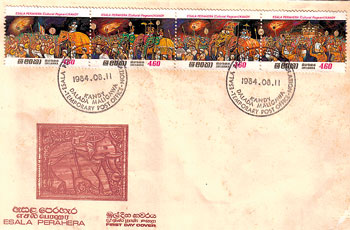A tradition dating back to the 4th century
continues to this day in the form of the Esala Perahera – the annual cultural pageant is held during the month of Esala (July/August). Starting in Anuradhapura it has been repeated in every capital city in Sri Lanka
throughout the days of the ancient kings and though the kings are no more, is now held in Kandy, the last capital of the Sinhalese kingdom.
The Perahera pays
homage to the Sri Dalada – the sacred Tooth Relic of the Buddha, the most venerated object for the Buddhists throughout the world. The grandeur of the pageant attracts people of all religions and faiths from numerous countries.
It was King Sirimeghavanna
(303 – 331 AC) ruling in Anuradhapura, who ordered that the Sri Dalada should be brought out from its enshrined place so that the people could pay homage once a year. The Tooth Relic was brought to Sri Lanka in the ninth year of his reign (312) from Dantapura in Kalinga, India by a
princess disguised as a Brahmin lady hiding the Relic in her hair. The king received the Relic with honour, kept it in a shrine within the royal palace. At the annual festival the Relic was taken in a
procession to the Abhayagiri Vihara and exhibited to the public.
Over the centuries, every time a new
capital was established, the king ensured that the Tooth Relic was carefully secured. It was accepted that whoever had the Tooth Relic was the
monarch of Sri Lanka.
In Kandy, the last royal capital of the kings, the
Perahera turned out to be more a Hindu ceremony than one to pay
homage to the Tooth Relic.
Processions held in the name of the four deities – Skandha, Natha, Pattini and Vishnu whose temples – referred to as 'devales' – in Kandy paraded the streets. When Upali Maha Thera from Siam was in Sri Lanka in 1753 for the 'upasampada' ceremony he noticed the Hindu bias in the Esala festival and
prevailed upon
King Kirti Sri Rajasinghe
(1747 – 82) to change the format to include the Dalada Perahera –
procession of the Tooth Relic – taking precedence over the other processions. The King agreed.
The King himself had walked in the Randoli Perahera, the most
colourful stage of the
procession, during the last five nights. The King was accompanied by his retinue comprising the two Adigars (Chief Ministers), the Dissawes (Provincial chieftains) and other Royal Court officials. Today the King has been replaced by the Diyawadana Nilame – the lay custodian of the Tooth Relic along with
other officials of the Temple of the Tooth.
To this day thousands flock the streets of Kandy to witness this great
spectacle.
A set of four stamps released in August 1984 vividly portrays the great spectacle.
Whip crackers lead the way announcing the arrival of the Perahera by
cracking the whips which make a sound to be heard by everyone around so that they can get ready to view the Perahera.
The flag bearers follow in single file on either side of the road carrying the, standards of the different provinces and temples.
The torch-bearers carrying lit-up torches using copra walk at regular intervals keeping with the ancient form of providing light to the procession.
Gaily decorated
elephants carrying Maligawa officials,
drummers playing a
variety of traditional instruments and dancers performing diverse forms of dancing add lot of colour to the Perahera.
The sequence of the Perahera is captured in the four stamps.
A Dalada Maligawa
official designated as 'Peramune Raala'
(Front Officer) carries an old manuscript called the 'Lekam-mitiya' containing records of lands belonging to the Maligawa and names of the Maligawa service staff. On the back of the second elephant rides the 'Gajanayake Nilame' – chieftain in charge of the elephants followed by the 'Kaariya Korala' – officer next in command to the Diyawadana Nilame.
The caparisoned Maligawa tusker carrying the golden casket walks majestically on the white cloth spread in front as a mark of respect. The casket
symbolizes the Tooth Relic which is not taken in the procession. The tusker is flanked by two elephants with their riders fanning and sprinkling flowers in veneration. A canopy is held over the casket. A group of singers recite verses in praise of the Relic.
The most skilled
dancers and drummers perform in front of the Diyawadana Nilame,
who, clad in his official dress, walks behind the tusker, with his attendant officials. The traditional weaponry is carried by bearers on either side.
The four 'devale'
processions follow with the lay officials in charge of each temple walking behind the elephant
carrying the apparel and insignia. These are mini versions of the Maligawa Perahera with dancers and drummers participating.
The four Devala
processions follow. These are not depicted in the stamps. The Basnayaka Nilame of each devala walks in the procession. |


